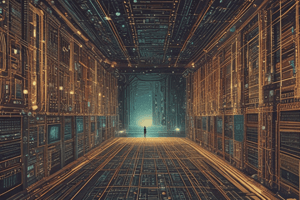Podcast
Questions and Answers
How many possible values can be represented with 5 bits?
How many possible values can be represented with 5 bits?
- 16
- 32
- 128 (correct)
- 64
What is the term used to describe 4 bits of data?
What is the term used to describe 4 bits of data?
- Kilobyte
- Byte
- Megabyte
- Nibble (correct)
What is the decimal equivalent of the binary number 1111?
What is the decimal equivalent of the binary number 1111?
- 511
- 15 (correct)
- 16
- 255
Which of the following is a unit of memory often used to represent the storage capacity of computers?
Which of the following is a unit of memory often used to represent the storage capacity of computers?
How many bytes are in 1024 kilobytes (KB)?
How many bytes are in 1024 kilobytes (KB)?
What is the relationship between a byte and a single character on a keyboard?
What is the relationship between a byte and a single character on a keyboard?
What is the primary reason why computers typically store and manipulate data in groups of 8 bits (bytes)?
What is the primary reason why computers typically store and manipulate data in groups of 8 bits (bytes)?
Which of the following storage capacities is the largest?
Which of the following storage capacities is the largest?
What is the primary function of software in a computer?
What is the primary function of software in a computer?
What is the main purpose of Automatic Test Equipment (ATE) in the aircraft industry?
What is the main purpose of Automatic Test Equipment (ATE) in the aircraft industry?
Which of the following is NOT typically housed within a computer case?
Which of the following is NOT typically housed within a computer case?
What is the role of the operating system in a computer?
What is the role of the operating system in a computer?
What is the main reason for periodic software updates in aircraft systems?
What is the main reason for periodic software updates in aircraft systems?
What is the main difference between RAM and ROM?
What is the main difference between RAM and ROM?
What is the purpose of a graphics card in a computer?
What is the purpose of a graphics card in a computer?
What is the primary function of a motherboard?
What is the primary function of a motherboard?
What is the significance of cooling systems in modern computers?
What is the significance of cooling systems in modern computers?
Which of the following is considered a microcomputer?
Which of the following is considered a microcomputer?
What is the primary function of the I/O circuitry in a computer?
What is the primary function of the I/O circuitry in a computer?
What is the role of the CPU (Central Processing Unit) in a computer?
What is the role of the CPU (Central Processing Unit) in a computer?
Which of the following is NOT a primary component of a modern microcomputer?
Which of the following is NOT a primary component of a modern microcomputer?
What is the primary difference between a Flight Control Computer (FCC) and a personal computer?
What is the primary difference between a Flight Control Computer (FCC) and a personal computer?
What is NOT a characteristic of a Flight Control Computer (FCC)?
What is NOT a characteristic of a Flight Control Computer (FCC)?
What is the main difference between the CPU of a simple calculator and that of a modern computer?
What is the main difference between the CPU of a simple calculator and that of a modern computer?
Which of the following is an example of a computer peripheral?
Which of the following is an example of a computer peripheral?
Which of the following best describes the relationship between a computer's CPU and Main Memory (RAM)?
Which of the following best describes the relationship between a computer's CPU and Main Memory (RAM)?
What is the main purpose of a computer processor?
What is the main purpose of a computer processor?
What is the primary difference between a floppy disk and a hard disk in terms of their physical composition?
What is the primary difference between a floppy disk and a hard disk in terms of their physical composition?
What happens to data stored on a magnetic disc when new data is written to the same area?
What happens to data stored on a magnetic disc when new data is written to the same area?
Which statement accurately describes the relationship between data density and track size on a magnetic disc?
Which statement accurately describes the relationship between data density and track size on a magnetic disc?
What is the primary characteristic that distinguishes semiconductor memory from magnetic disc storage?
What is the primary characteristic that distinguishes semiconductor memory from magnetic disc storage?
What is the primary disadvantage of using semiconductor memory for data storage?
What is the primary disadvantage of using semiconductor memory for data storage?
Which of the following components is NOT typically found on a computer's motherboard?
Which of the following components is NOT typically found on a computer's motherboard?
What is the primary function of transistors in a computer?
What is the primary function of transistors in a computer?
What is the relationship between bits, bytes, and a computer's memory?
What is the relationship between bits, bytes, and a computer's memory?
Which of these is NOT a type of computer-related software?
Which of these is NOT a type of computer-related software?
Which of the following accurately describes how a computer processes data?
Which of the following accurately describes how a computer processes data?
What is the significance of the binary numbering system in computer science?
What is the significance of the binary numbering system in computer science?
Flashcards
Bits
Bits
The smallest unit of data in computing, representing a binary state, either 0 or 1.
Bytes
Bytes
A group of 8 bits, used to encode a single character of data.
CPU
CPU
Central Processing Unit; the primary component that executes instructions in a computer.
RAM
RAM
Signup and view all the flashcards
ROM
ROM
Signup and view all the flashcards
Transistors
Transistors
Signup and view all the flashcards
Binary System
Binary System
Signup and view all the flashcards
1 bit
1 bit
Signup and view all the flashcards
4 bits (Nibble)
4 bits (Nibble)
Signup and view all the flashcards
8 bits (Byte)
8 bits (Byte)
Signup and view all the flashcards
ASCII
ASCII
Signup and view all the flashcards
Kilobyte (KB)
Kilobyte (KB)
Signup and view all the flashcards
Megabyte (MB)
Megabyte (MB)
Signup and view all the flashcards
Gigabyte (GB)
Gigabyte (GB)
Signup and view all the flashcards
Terabyte (TB)
Terabyte (TB)
Signup and view all the flashcards
Software
Software
Signup and view all the flashcards
Hardware
Hardware
Signup and view all the flashcards
Operating System
Operating System
Signup and view all the flashcards
Automatic Test Equipment (ATE)
Automatic Test Equipment (ATE)
Signup and view all the flashcards
Motherboard
Motherboard
Signup and view all the flashcards
Microprocessor
Microprocessor
Signup and view all the flashcards
Cooling Systems
Cooling Systems
Signup and view all the flashcards
Memory (RAM and ROM)
Memory (RAM and ROM)
Signup and view all the flashcards
Input Devices
Input Devices
Signup and view all the flashcards
Software Updates
Software Updates
Signup and view all the flashcards
Magnetic Disk Storage
Magnetic Disk Storage
Signup and view all the flashcards
Volatile Memory
Volatile Memory
Signup and view all the flashcards
Bit Cell
Bit Cell
Signup and view all the flashcards
Data Density
Data Density
Signup and view all the flashcards
Primary Storage
Primary Storage
Signup and view all the flashcards
Main Memory (RAM)
Main Memory (RAM)
Signup and view all the flashcards
I/O Circuitry
I/O Circuitry
Signup and view all the flashcards
Graphics Processing Unit (GPU)
Graphics Processing Unit (GPU)
Signup and view all the flashcards
Flight Control Computer (FCC)
Flight Control Computer (FCC)
Signup and view all the flashcards
Computer Processor
Computer Processor
Signup and view all the flashcards
Calculator
Calculator
Signup and view all the flashcards
Central Processing Unit (CPU)
Central Processing Unit (CPU)
Signup and view all the flashcards
Resource Management
Resource Management
Signup and view all the flashcards
Program Execution
Program Execution
Signup and view all the flashcards
Study Notes
Basic Computer Structure (5.6.1)
- Learning Objectives include describing computer terminology (bits, bytes, software, hardware, CPU, IC, RAM, ROM, PROM) and applications in aircraft systems.
Computer Terminology
- Computers manipulate binary data (1s and 0s).
- Input devices translate data into output.
- Complex hardware/software is a combination of components.
- The motherboard is a core component, with CPU and RAM slots, alongside other integrated circuits for peripherals.
- Computer outputs are diverse and depend on running software.
Binary Digits
- Transistors switch between ON and OFF states with voltage applied to the base.
- Computers use binary numbering (0 and 1).
- HIGH (ON/1) is typically 5V DC and LOW (OFF/0) is typically 0V DC.
Bits
- A bit is a binary digit (1 or 0) used in computer circuits, representing information.
- Bits combine to form logic circuits within the computer.
AND Gate
- The light circuit works as an AND gate. This means the light only turns on when both input "A" and "B" are high (1).
- The circuit's logic demonstrates how computers process information.
Bits, Nibbles, and Bytes
- A bit is the smallest unit of computer information, with only two possible values (0 and 1).
- Increasing the number of bits increases the number of states they can represent exponentially.
- A nibble is 4 bits.
- A byte is 8 bits.
- A byte is often used to represent a single character in a computer system internally.
8 Bits = 1 Byte of Data
- Computer storage is often measured in kilobytes (KB), megabytes (MB), gigabytes (GB), and terabytes (TB).
- 1 KB = 1024 bytes, 1 MB = 1024 KB, 1 GB = 1024 MB, 1 TB = 1024 GB.
Integrated Circuits (ICs)
- ICs (microchips) are assemblies of electronic components on a single unit.
- Integrated circuits allow for more complex logic actions and miniaturization of components in computers.
- ICs reduce the size and weight of computers, improve reliability, lower costs, and increase performance.
- Disadvantages of ICs include problems with repair (replacement often the solution).
Computer Hardware
- Computer hardware includes the physical components: case, motherboard, CPU, memory (RAM, ROM), graphics card, sound card, input devices (mouse, keyboard), output devices (monitor, speakers), and related circuit components like resistors, transistors, capacitors.
Studying That Suits You
Use AI to generate personalized quizzes and flashcards to suit your learning preferences.




